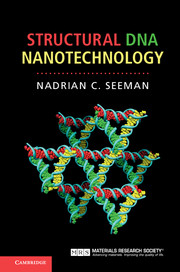Book contents
- Frontmatter
- Contents
- Preface
- 1 The origin of structural DNA nanotechnology
- 2 The design of DNA sequences for branched systems
- 3 Motif design based on reciprocal exchange
- 4 Single-stranded DNA topology and motif design
- 5 Experimental techniques
- 6 A short historical interlude: the search for robust DNA motifs
- 7 Combining DNA motifs into larger multi-component constructs
- 8 DNA nanomechanical devices
- 9 DNA origami and DNA bricks
- 10 Combining structure and motion
- 11 Self-replicating systems
- 12 Computing with DNA
- 13 Not just plain vanilla DNA nanotechnology: other pairings, other backbones
- 14 DNA nanotechnology organizing other materials
- Afterword
- Index
- References
5 - Experimental techniques
Published online by Cambridge University Press: 05 December 2015
- Frontmatter
- Contents
- Preface
- 1 The origin of structural DNA nanotechnology
- 2 The design of DNA sequences for branched systems
- 3 Motif design based on reciprocal exchange
- 4 Single-stranded DNA topology and motif design
- 5 Experimental techniques
- 6 A short historical interlude: the search for robust DNA motifs
- 7 Combining DNA motifs into larger multi-component constructs
- 8 DNA nanomechanical devices
- 9 DNA origami and DNA bricks
- 10 Combining structure and motion
- 11 Self-replicating systems
- 12 Computing with DNA
- 13 Not just plain vanilla DNA nanotechnology: other pairings, other backbones
- 14 DNA nanotechnology organizing other materials
- Afterword
- Index
- References
Summary
The preceding chapters have emphasized theoretical methods for designing sequences and motifs in structural DNA nanotechnology. We have implicitly assumed that there was some way to put DNA strands together to produce target products. In this chapter, we will discuss how this is done. Interspersed with the theoretical methods have been obscure comments that such-and-such motif forms well or does not form well, or perhaps does not form at all. It is now time to discuss the experimental techniques that give us the right to make such claims. Many of the construction and analysis experiments done so far in structural DNA nanotechnology have been done on a scale ranging from femtomoles to nanomoles, which is the scale on which the techniques of molecular biology are employed. Structural DNA nanotechnology is indeed somewhat parasitic on molecular biology, both in terms of its methods and in terms of the materials that are commercially available because of the molecular biology and biotechnology enterprises. These range from enzymes, such as restriction enzymes, ligases, and topoisomerases, to specialized components for synthesizing and modifying DNA strands.
Construction methods
Synthesis and purification
Solid-support methodology for the synthesis of DNA-containing designated sequences is the central enabling methodology for the pursuit of structural DNA nanotechnology. This field is still at the stage where the key principles are being elucidated. Consequently, it is both economical and convenient to perform syntheses on relatively small scales, e.g., 10–200 nm. On a well-tuned synthesizer, one can achieve apparent step yields of 99.2% or so based on trityl group deprotection; these step yields lead to about 45% yield of crude target product in the synthesis of a 100-mer. Despite numerous attempts at alternative approaches, purification by denaturing gel remains the most reliable (and tedious) method of separating target molecules from failure products. It is worth pointing out that DNA of this length frequently has suffered damage during the synthesis, so reproducing (and amplifying) it with polymerase chain reaction (PCR) may be advisable in cases where high chemical purity is an issue. These cases include the accurate measurement of physical properties, and crystal formation. PCR is a very good method to amplify small numbers of molecules up to the picomole scale; however, if larger quantities are needed, say for crystallization, synthesis followed by an orthogonal dimension of HPLC is likely to be the most effective way of getting larger quantities.
- Type
- Chapter
- Information
- Structural DNA Nanotechnology , pp. 64 - 87Publisher: Cambridge University PressPrint publication year: 2016



